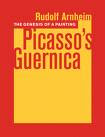
A common feature of 'modern artist' biographies is the inclusion of stories that illustrate the artist's propensity for eccentric, bohemian, or deviant behavior. While clearly contributing to the mythology of the 'modern artist', these stories can be rather fun (and also a little disturbing). I was reading Gils van Hensbergen's Guernica: The Biography of a Twentieth-Century Icon when I ran across this little nugget:
"I have a child by this man. It's my place to be here with him," said Marie-Therese. "You can leave right now." Dora said, "I have as much reason as you have to be here. I haven't borne him a child but I don't see what difference that makes."
Picasso refused to intervene, preferring to watch the two women fight it out.
Finally, Marie-Therese turned to me and said, "Make up your mind. Which one of us goes?" It was a hard decision to make. I liked them both, for different reasons: Marie-Therese because she was sweet and gentle and did whatever I wanted her to do, and Dora because she was intelligent... I told them they'd have to fight it out themselves. So they began to wrestle.Picasso's relationships with women were, to say the least, complicated. During the making of Guernica Picasso would stay with his wife(?) Marie-Therese and their daughter on the weekends, but during the week he was working in Paris and accompanied by his mistress Dora Maar. This tale is the kind of soap-opera-situation that no one imagines would happen in 'real life', but when it happens to an artist we nod our heads and chuckle softly to ourselves.
Stories such as this one mythologize our notions of artistic practice by suggesting that creative power at least partially derives from the artist's capacity to break the rules. It is often assumed that living in a different, unique, or unusual is directly related to (or at least naturally associated with) the ability to produce works of art that exhibit a high degree of originality. But is this the way that creativity works? Is creative practice really antithetical to commitment and responsibility?




No comments:
Post a Comment